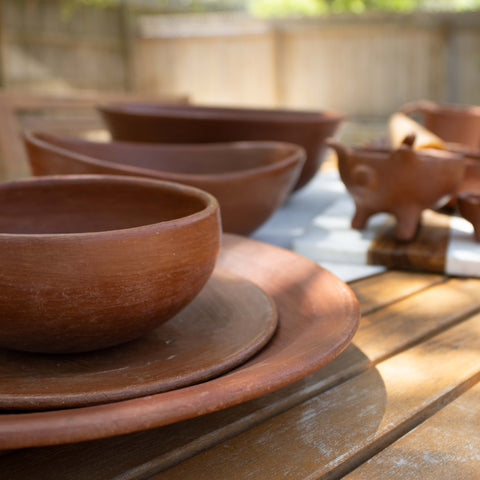Embark with us in a journey to the community of San Marcos Tlapazola, a rural gem whose very name, "place of the quail," evokes a sense of wonder. Nestled in the Oaxaca Valley, this Zapotec town is famous for its time-honored craft of Barro Rojo, red clay pottery. Prepare to be captivated by the distinct terracotta-style clay, showcasing a myriad of rich red hues, and join us as we explore the remarkable world of these skilled artisans, whose dedication and craftsmanship will leave you in awe.
The Road to San Marcos Tlapazola
Our journey began traveling the narrow highway, surrounded by hills and majestic mountains, the beauty of the surrounding landscape unfolded before our eyes. San Marcos Tlapazola is located 22 miles from the city of Oaxaca and embarking on the road there is an experience like no other.
San Marcos Tlapazola’s population is 100% indigenous Zapotec and earns their living mostly from agriculture and pottery. However, it is the women who are expert potters and make each piece by hand. Although they do not use a potter's wheel, each piece they make is an exceptional work that demonstrates their great craftsmanship. The women work non-stop as they oversee every step of the process. Each of them mixes the clay, shapes their piece, and fires it as we learned during our visit.

A Glimpse into the Craft
Our first stop in our attempt to learn more about barro negro was at the renowned workshop/cooperative, "Mujeres del Barro Rojo" (Women of the Red Clay), founded by master potter Macrina Mateo. It was here that we had the privilege of meeting Elia Mateo, another master potter who graciously shared captivating tales of the city's history, the pottery of the place, and their established oven unique to the town.
San Marcos Tlapazola is an indigenous community, and its cultural heritage shines through the vibrant attire of the women. Adorned in traditional clothing bursting with color and elegance, we could admire the daily essence of Mexico’s cultural heritage: wearing long skirts and blouses, layered with aprons and rebozos, most women also had their long dark hair intricately braided with ribbons. For us, this was a sight of enchantment that added to our admiration for these women’s trade.
We continued our visit, stopping at various talleres/workshops of women who warmly welcomed us into their world of artistry. Each potter graciously shared insights into their craft and creative process and was willing to do a demonstration of the craft. What struck us most was the sense of community and shared knowledge among the potters. Despite operating separate workshops, they wholeheartedly support one another, ensuring the success of each individual and celebrating the collective growth of their craft. For the women of the community, pottery is a shared knowledge and the success of one is the success of the town.

A Master and Her Legacy
Our last destination was El Taller de Emerenciana, where we were greeted by the esteemed master potter, Emerenciana Aquino Martínez. Welcoming us with pleasure, she opened the doors to her showroom: a room with an altar centered in one wall, a door that led to her house, and tables and shelves filled with pieces for sale on all others; a testament to the countless hours she has spent perfecting her art, often sacrificing rest to meticulously polish her creations.
Emerenciana's journey in Barro Rojo pottery began at the age of 12, under the guidance of her mother, Justa, who inherited the trade from her own mother, and so on, demonstrating that this is a generational knowledge passed down from women.
We talked for a while in one of the most illuminating and refreshing conversations where we asked her about barro rojo, and she, in turn, rejoiced in showing us all of her creations. As she showed us each of her pieces, she demonstrated the extensive knowledge she has her trade as well as the passion and love she pours into every single one of her pieces.

Barro Rojo: The Mastery of Handcraft
As we delve deeper into the mesmerizing world of San Marcos Tlapazola's Barro Rojo pottery, it is essential to highlight the awe-inspiring process that transforms raw materials into stunning works of art. Step by step, these talented women craft each piece with dedication and a profound connection to their ancestral roots.
It all begins with the extraction of the clay itself, a laborious task that takes the artisans on a three-hour trek through rugged mountainous terrain, since there is no way to get there with animals, much less a vehicle. After gathering the clay, they return carrying it on their backs (yes, a three-hour trip with rocks held by a rebozo on their backs).
With their hands as their primary tools, these skilled women bring the clay to life. Their expertise lies not in the precision of a potter's wheel, but in the deftness of their touch and the connection they forge with the clay. These women’s remarkable skill and craftsmanship is evident in each piece they create. From pots and plates, to mugs, vases, casseroles, comales, tumblers, jugs, bowls, and the cutest pieces resembling animals like pigs, chickens, ducks, rabbits, donkeys, and bulls, among many other practical creations.

After a day or two of careful drying, the artisans embark on the next phase of the process. On their knees, in complete contact with the earth, they engage in the laborious and time-honored process of burnishing: using a mixture of water and the same red clay, they polish each piece, expertly smoothing them by hand. This meticulous form of “glazing” further refines the texture, makes it more durable, and enhances the depth of color. The smoothness of each piece is highly dependent on how many times the piece is burnished: the more it is burnished, the less ridges it has.
Finally, the pieces are cured in open fire in what Emerenciana referred to as “cielo abierto” which translates as “open sky,” in a makeshift oven out in the open expertly built on the ground with what was available, such as iron scraps and pieces of the same clay; a burning that has remained since its pre-Hispanic origin.

Emerenciana's passion extends beyond her workshop in Tlapazola. Since 2017, Emerenciana is the founder and president of the Tlapazola Association of Women Entrepreneurs (Asociación de Mujeres Emprendedoras de Tlapazola), who, together with over 60 women potters of the town, carry an Exhibition of Barro Negro Pottery to promote the town’s talent in July. Emerenciana’s dedication to her craft, her talent, and joyful spirit is clearly infused in each one of the barro rojo pieces you can find at Lolo.
Today, Lolo is honored to introduce pieces made of barro rojo, a true reminder that pottery is more than just a craft; it is a cultural treasure passed down through generations. In this visit we learned that the artisans, with unwavering devotion, continue to honor the ancient practices, protecting and upholding a legacy that spans centuries. Also, we reflected onto the power of their craft: through their hands the vivid creations of barro rojo stand as a testament to the artesanas remarkable skill and unwavering commitment and that is what we want to depict by introducing this collection.
---
We will continue to expand on this as we discuss the special care needed for different clay/ceramic products and specify how to cure a Barro Rojo pot in future blogs. Is there anything else you would like for us to dive into? Let us know in the comments below! You know we love to read your comments and look forward to learning your thoughts.
Also, don’t forget to follow us on social media as @lolomercadito as we share parts of this journey and more tid bits from Emerenciana and Barro Negro. And, as always, if you liked this article, remember that we share many more for those subscribed to our newsletter, so be sure to subscribe here!










3 comments
Iris
Wondering about the conversations you had. Was it all in Spanish. Does anyone speak English?
Dorothy
I love the red clay handcrafted by Las Mujeres del Barro Rojo. Would you please provide me with an update on when you might have back in stock the red clay olla? I’ve been waiting for for two and a half months now. Would love to purchase one. Thank you.
Melissa
This was a thrilling article! I thoroughly enjoyed learning about the legacy of the barro rojo craft and feel so humbled and honored that I have a wonderful barro rojo mug from El Taller de Emerenciana.